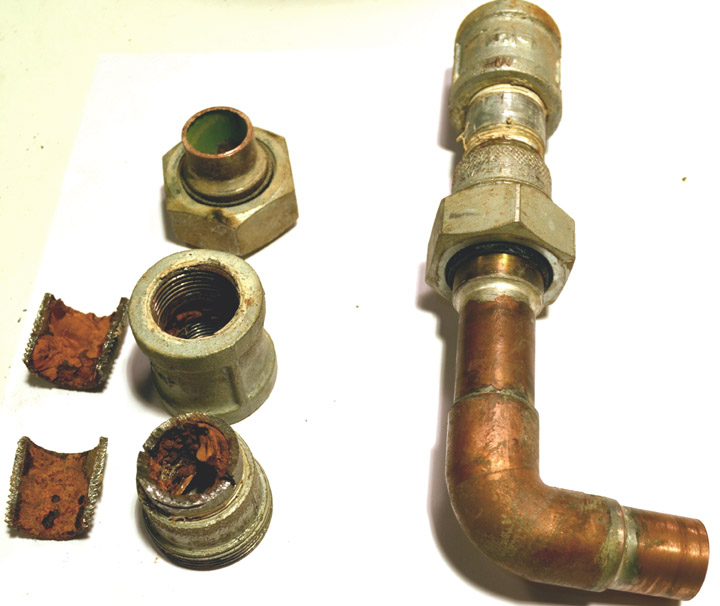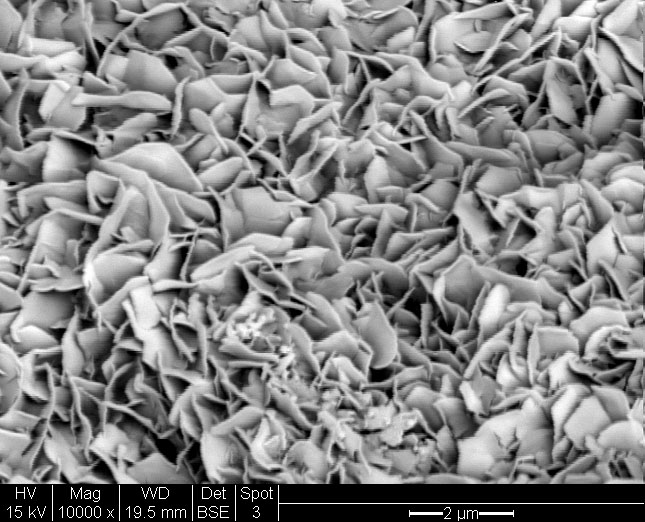The hot water side in premise plumbing tends to have a higher load of heavy metals than does the cold side. One factor in causing this higher load is the common presence of galvanized fittings on water heaters in homes with copper piping.

Galvanized fittings used to connect water heater to copper water lines, utility 2.
Scales
Scales are dominated by the iron mineral lepidocrocite (FeOOH)

Water Chemistry: The Hot Water Side
| Two water heaters, water samples from hot outlet (top) and tank bottom, utility 02 | |||||||||||||||||
| Field parameters | Lab measurements (all units in µg/L) | ||||||||||||||||
| fixture | postion | pH | ORP, mv | Turb, NTU | free Cl mg/L | Type | Al | As | Ba | Cd | Co | Cu | Fe | Pb | Mn | Ni | Zn |
| WH#1 | top | 8.35 | 266 | 0.80 | 0.36 | Tot | 270 | 0.73 | 52 | <0.1 | 0.57 | 130 | 89 | 17 | 5.7 | 3.1 | 98 |
| WH#1 | top | Dis | 150 | 0.64 | 52 | <0.1 | <0.5 | 110 | 38 | 15 | 2.8 | 2.1 | 67 | ||||
| WH#1 | bottom | 8.40 | 269 | 1800 | 0.17 | Tot | 5200 | 1.00 | 58 | 1.20 | 1.50 | 410 | 140 | 69 | 11 | 47 | 2300 |
| WH#1 | bottom | Dis | 330 | 0.61 | 51 | 0.25 | <0.5 | 210 | 48 | 6.7 | 5.5 | 9.6 | 200 | ||||
| WH#2 | top | 8.35 | 270 | 0.75 | 0.05 | Tot | 310 | 0.70 | 54 | <0.1 | 0.54 | 460 | 110 | 29 | 4.6 | 4.9 | 460 |
| WH#2 | top | Dis | 180 | 0.68 | 53 | <0.1 | <0.5 | 280 | 45 | 11 | 2.7 | 2.4 | 100 | ||||
| WH#2 | bottom | Tot | 180 | 6.60 | 140 | 2.40 | 90 | 3500 | 1300 | 68 | 55 | 490 | 950 | ||||
| WH#2 | bottom | Dis | 320 | 0.72 | 54 | <0.1 | <0.5 | 30 | 83 | 2.2 | 5.3 | 3.1 | 9 | ||||
| Kitchen, cold tap | 8.35 | 295 | 0.28 | 0.4 | Tot | 46 | 0.65 | 54 | <0.1 | <0.5 | 22 | 18 | 0.61 | 1.5 | 2.0 | 73 | |
| Kitchen, cold tap | Dis | 43 | 0.64 | 53 | <0.1 | <0.5 | 23 | 21 | 1.3 | 3.1 | 2.4 | 62 | |||||
Many of the Pb measurements from the water heaters are above the LCR action level of 15 µg/L, and most of the other metals are also substantially elevated above the levels found on the cold water side. The bottom of the tank contains high concentrations of particles rich in heavy metals, suggesting it would be good policy to periodicaly drain off a few liters of the bottom water. Below are two analyses of the sludge found in the bottom of water heaters that had been in service ~10 years.
| Bottom sludge from water heaters, utility 02 | |||
| Element | Concentration | WH#3 | WH#2 |
| Al | % | 4.68 | 27.8 |
| Ca | % | 27.7 | 9.30 |
| Fe | % | 9.24 | 0.82 |
| K | % | 1.34 | 0.00 |
| Mg | % | 8.67 | 5.53 |
| Mn | % | 4.84 | 0.05 |
| Na | % | 0.86 | 2.64 |
| P | % | 0.58 | 2.66 |
| Si | % | 5.97 | 5.20 |
| Ba | mg/kg | 544 | 654 |
| Cl | mg/kg | 2836 | 3105 |
| Cu | mg/kg | 22720 | 17344 |
| Ni | mg/kg | 395 | 2140 |
| Pb | mg/kg | 683 | 929 |
| S | mg/kg | 386 | 728 |
| Sr | mg/kg | 290 | 579 |
| V | mg/kg | 1.54 | 7.15 |
| Zn | mg/kg | 2438 | 7526 |